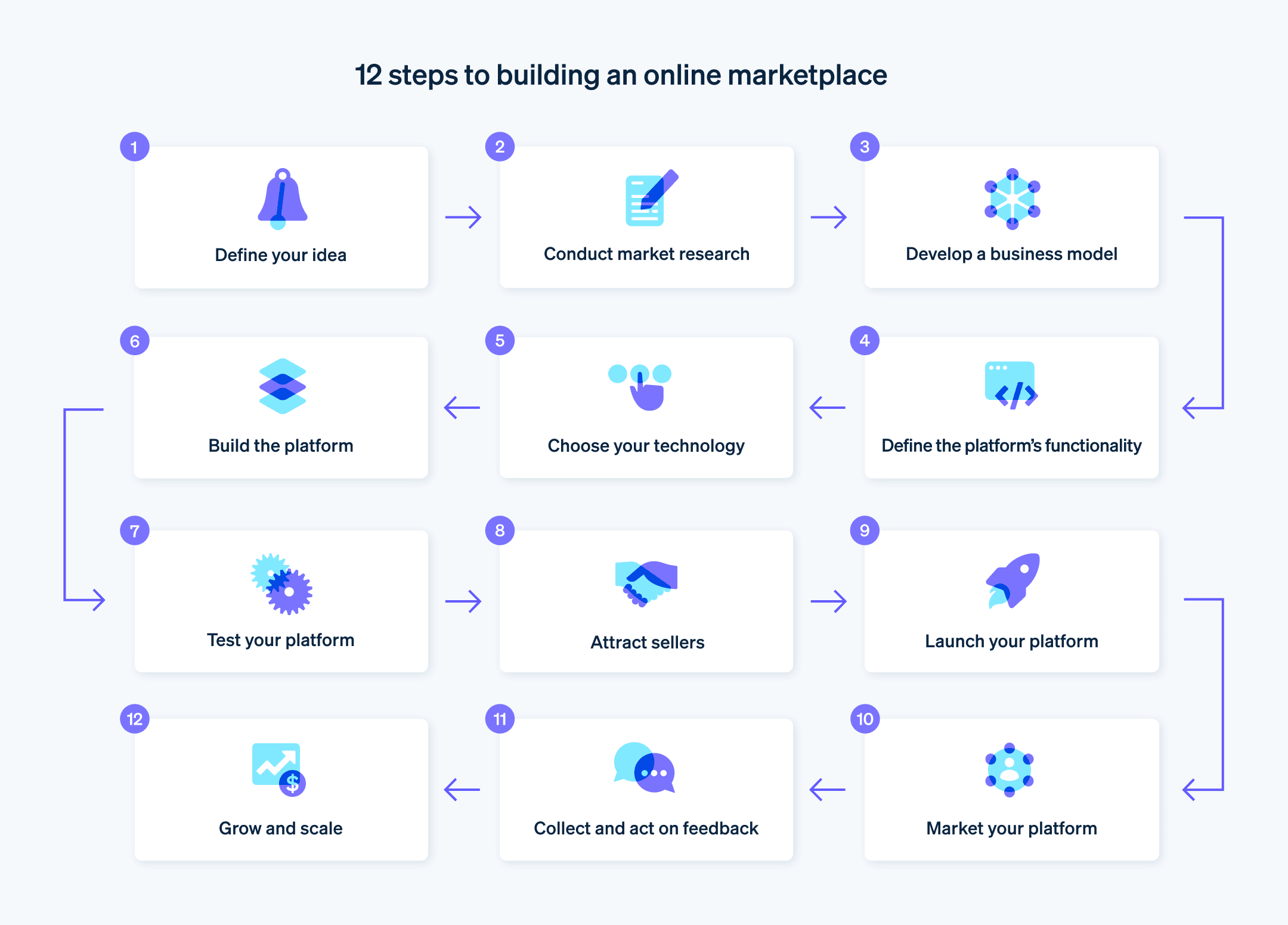随着数字商务的持续增长,企业正在寻求创新的方式来满足客户需求并开辟新的收入来源。近年增长迅速的一个机会就是在线交易市场模式。根据 Grand View Research 的一份报告,全球在线交易市场的收入预计到 2027 年将达到 27.1 万亿美元。像亚马逊、Airbnb 和 Uber 等在线交易市场在各自的行业中掀起了变革,证明了这一商业模式的有效性和可扩展性。
建立一个在线交易市场需要谨慎规划、战略决策和细致的执行。整个过程包括定义概念、进行市场调研、开发商业模式、设计平台、吸引用户,并根据反馈进行优化。尽管面临挑战,但成功建立在线交易市场带来的回报十分可观,它为企业提供了更大规模的商务机会、持续的收入来源以及强大的数字存在。以下是开始构建、规划并推出新的在线交易市场时需考虑的重要因素。
目录
- 什么是交易市场?
- 交易市场与电子商务网站有何不同?
- 在线交易市场的类型和商业模式
- 交易市场支付处理:如何选择提供商
- 如何建立交易市场
什么是交易市场?
交易市场是一种电子商务平台,多个第三方提供商在平台上提供产品或服务,由交易市场的运营者处理交易。在线交易市场是实体市场或购物中心的数字等价物,多个提供商在此出售产品。
根据交易性质,交易市场可以分为 B2B(企业对企业)、B2C(企业对消费者)或 C2C(消费者对消费者)平台。知名的在线交易市场包括亚马逊、eBay 和 Etsy。
交易市场与电子商务网站有何不同?
尽管交易市场和普通的电子商务网站都在线运营,促进商品或服务的买卖,但它们在多个关键方面有所不同:
卖家多样性
交易市场聚合了多个第三方卖家的产品或服务,为客户提供广泛的选择和多样性。而传统电子商务网站一般只销售一家企业的产品或服务。库存管理
在交易市场中,各个卖家自行管理库存,交易市场平台本身不持有任何库存。传统电子商务网站通常管理自己的库存和供应链,唯一的例外是“代发货”模式,这种零售履行方式允许商店在没有库存的情况下销售商品,而是从第三方采购并直接发货给客户。价格竞争
由于交易市场容纳了多个卖家,通常会有类似产品的直接价格竞争。在传统电子商务网站上,价格由企业设定,不存在同一平台上的直接竞争。营收模式
交易市场通常通过收取平台交易的佣金或费用来获利,而传统电子商务网站则通过直接销售产品或服务来获取收入。履约责任
在交易市场中,卖家通常负责向客户发货,尽管有些交易市场可能提供集中履约服务。在传统电子商务模式中,网站运营的公司负责履约。客户关系
在交易市场中,客户关系通常由交易市场与个别卖家共同维护。而在传统电子商务网站上,客户关系仅限于客户与公司之间。评论和评分
大多数交易市场都有系统,允许客户对单个卖家进行评分和评价,帮助建立信任并为未来客户提供信息。虽然电子商务网站也可以有评论和评分系统,但一般只关注产品而非卖家。
企业需要理解这些区别,然后决定是否适合将交易市场作为近期和长期的商业模式。如果交易市场是合适的选择,下一步是了解各种类型的交易市场及其支持的商业模式。
在线交易市场的类型和商业模式
不同类型的在线交易市场各具特点和商业模式,:这些包括:
企业对消费者 (B2C) 交易市场
这些平台允许企业向个人消费者销售商品。例如,亚马逊就是这种模式,不同企业在亚马逊上向客户销售商品,亚马逊从每笔销售中收取一定比例作为佣金。消费者对消费者 (C2C) 交易市场
这些平台允许消费者之间出售商品。例如,eBay 允许个人通过竞价将物品出售给出价最高者。此类交易市场通常通过收取上架费或交易费获利。企业对企业 (B2B) 交易市场
这些平台促进了企业之间的交易。例如,阿里巴巴允许制造商和批发商向全球的企业销售商品。它们通常通过收取会员费或交易费来获利。服务型交易市场
这些平台连接服务提供商和有需求的客户。Uber 连接司机与乘客,Upwork 连接自由职业者和客户。这些平台通常从每笔交易中抽取佣金。垂直交易市场
这些平台专注于某种特定类型的产品或服务。例如,Etsy 专注于手工艺品和复古物品,Zillow 专注于房地产。它们的营收模式各不相同,但通常涉及交易或上架费用。水平交易市场
这些平台出售跨行业的多种产品和服务。亚马逊和 eBay 就是很好的例子,它们提供广泛的产品种类。它们通常通过向卖家收取销售佣金获利。点对点 (P2P) 租赁市场
这些平台便于用户之间进行物品的临时租赁。例如,Airbnb 允许个人将房屋出租给旅行者。这类平台通常通过向每次预订收取服务费获利。去中心化交易市场
这种较新的市场类型利用区块链技术实现无中心化的点对点交易。例如,OpenBazaar 和 OriginProtocol。它们通常不收取交易费用,但可能通过出售专有代币等方式盈利。混合型交易市场
这些平台结合了不同类型的市场。例如,亚马逊主要是一个 B2C 平台,但也包含 B2B(如 Amazon Business)和 C2C(用于旧货销售的 Amazon Marketplace)部分。
这些不同类型的交易市场展示了市场模式如何适应不同用户之间的多种交易和互动。为了获得这种灵活性带来的优势,企业应根据自身的独特优势和目标市场,战略性地选择最有利的市场模式。
交易市场的支付处理:如何选择提供商
支付处理和支付基础设施在在线交易市场的运营中至关重要。它们实现了买家与卖家之间的交易,是交易市场商业模式的核心。高效、安全且可靠的支付处理系统可以建立信任、提升用户体验、增加销售并推动业务增长。
选择支付处理提供商时,以下是一些需要考虑的因素:
费用
支付提供商的费用可能包括设置费、交易费、月费以及撤单费。一些提供商可能还会对如防欺诈等附加服务收费。例如,Stripe 收费为每笔交易收取百分比加固定费用,无需设置费或月费。全球覆盖与货币支持
如果您的市场服务于国际客户,则需要支付处理商能够处理多种货币并在多个国家/地区可用。Stripe 支持超过 135 种货币,并在全球 46 个国家/地区可用。集成难易度
支付系统应易于与交易市场平台集成。例如,Stripe 提供了灵活易用的 API。提现选项和结算周期
根据交易市场的性质,您可能需要为卖家提供灵活的提现选项。例如,Stripe 提供可定制的提现计划和多种支付方式,适合不同类型的交易市场。安全性
提供商应使用强大的安全措施来保护敏感的财务数据。Stripe 使用机器学习来检测欺诈,并获得了支付行业的最高认证——PCI 一级服务提供商认证。法规遵从性
支付处理商符合各地的法规要求,如数据保护和隐私法。Stripe 拥有严格的合规标准,包括欧洲客户的 GDPR 合规。客户支持
良好的客户支持对于解决可能出现的问题非常重要。Stripe 提供 24/7 全天候支持,包括电子邮件、聊天和电话支持。
考虑到这些因素,以下是选择支付处理提供商的一般流程:
1.定义需求
明确您的业务模式、目标用户群、运营的国家/地区、支持的货币、预算以及其他具体需求。
2.研究
研究不同提供商,了解他们的产品、成本和行业声誉。阅读评论并与其他使用其服务的企业交流。
3.对比
根据您的需求和他们的产品,评估不同的提供商。综合考虑上述因素:费用、全球覆盖、集成难易度、支付选项、安全性、合规性和客户支持。
4.测试
许多支付提供商提供沙盒环境用于测试。利用这些沙盒了解用户体验,并测试与您的平台的集成情况。
5.选择并集成
在评估了所有因素并进行测试后,您就可以做出明智的选择。选择最符合您需求的提供商并将其集成到您的交易市场中。
合适的支付处理解决方案不仅能确保交易的顺畅进行,还会对用户体验、信任度和交易市场的增长产生重大影响。
如何构建交易市场
构建在线交易市场涉及多个步骤,从定义创意到发布和推广平台。以下是流程的简要概述:

定义您的创意
首先定义交易市场的核心概念。将销售什么类型的产品或服务?谁是您的目标买家和卖家?有什么独特的卖点可以让您从现有平台中脱颖而出?进行市场调查
了解现有市场、竞争对手和客户需求。分析成功的交易市场,了解它们的优势以及您可以填补的市场空白。开发商业模式
决定您的盈利方式。可以是交易费、上架费、订阅费,或者是这些模式的组合。同时考虑定价策略,以及如何与竞争对手相比。定义平台的功能
列出平台需要的关键功能。这通常包括搜索和发现工具、用户个人资料、产品列表、安全支付系统、评价和评分系统,以及买卖双方的沟通工具。选择您的技术
您可以选择从零构建交易市场、使用预构建的平台或市场软件。根据预算、时间表和技术能力来决定。这方面也有许多支付处理集成解决方案,例如 Stripe。搭建平台
无论是从零开始开发还是使用预构建平台,您都需要实现已定义的功能。如果您自己不是开发人员,则需要雇佣一个开发团队。测试您的平台
在发布前,进行彻底测试以确保一切正常。这包括测试购买和销售流程、支付系统以及所有平台功能。吸引卖家
在吸引买家之前,您需要卖家。联系那些适合您市场的潜在卖家,可以考虑提供加入的激励措施。发布您的平台
在测试完所有功能并吸引到一些初始卖家后,您可以发布交易市场。可以先进行小规模的软发布,邀请一小群用户在真实环境中测试平台并提供反馈。推广您的平台
使用各种营销策略来吸引买家,这可以包括 SEO、内容营销、社交媒体营销、付费广告以及合作伙伴关系。收集和采纳反馈
当用户开始使用平台时,收集反馈以了解平台的优缺点。利用这些反馈不断改进平台。增长和扩展
随着交易市场的逐渐建立,考虑增长策略。这可以包括拓展新市场或类别、构建社区功能,或利用数据进行个性化推荐。
请记住,建立一个成功的交易市场需要建立信任并处理买卖双方的互动。这一过程需要根据用户反馈不断进行迭代和改进。投入足够的时间在初始阶段,可以为平台的成功发布和持续增长打下坚实的基础。
要了解有关 Stripe 如何为领先交易市场的支付提供支持的更多信息,请阅读此处的案例研究。
本文中的内容仅供一般信息和教育目的,不应被解释为法律或税务建议。Stripe 不保证或担保文章中信息的准确性、完整性、充分性或时效性。您应该寻求在您的司法管辖区获得执业许可的合格律师或会计师的建议,以就您的特定情况提供建议。